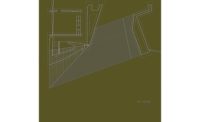Review of 'Thirteen Ways of Looking at a House'
By Stella Betts and David Leven with essays by Thomas de Monchaux

Thirteen Ways of Looking at a House, by Stella Betts and David Leven, with essays by Thomas de Monchaux. Oro Editions, 328 pages, $45.
Architects & Firms
A collaboration between Stella Betts and David Leven of LevenBetts, this book is a testament to how the ethic of iteration in architecture evolves into discipline. Certainly, not all architectural disciplines can be captured by a simple house, but, in this exercise, the duo has taken the house apart and put it back together in accordance with 13 themes and houses, each replete with wider cultural contexts that include literature, art, architectural precedents, and film.
Open House, Campsite, Doors and Windows, Steps and Stairs, Corridors, Courtyards, Curtains, Plumbing, House Plants, Plans, Structures, Thick and Thin, Home—when listed like this, they appear as nothing more than benign architectural elements. But in the authors’ minds, each is conceptualized as an indispensable element of a mis-en-scène that anticipates the events that invariably get acted out, with each one serving as another protagonist onstage.
These elements are charged by associations that are less centered on architecture than on the narrative that drives them. Imagine the embrace of Kar-wai’s atmospheric corridors in In the Mood for Love, Godard’s theatricalization of Libera’s Casa Malaparte stair in Contempt, or Kurosawa’s diaphanous curtains in High and Low—the presence of these backdrops, no matter their silence, sets the stage for the narrative itself.
Equally important, the human drama that unleashes itself onto architecture helps to tame the architect’s ambition for total control. Form can only do so much, especially as scenes of love, jealousy, rage, and anxiety cast different shadows within those spaces. Ironically, these architects maintain that control with meticulous attention, down to the detail lovingly drawn; for them, the open plan is a recipe for informality, but within intricate formal orders. It is their conception of an “open plan” in dialogue with an idea about specificity that disentangles programs from an assumed alignment with spatial enclosures. Despite the identification of 13 elements, the mission of this book is to dismantle the stability of their conventional definitions. They force us to “unlearn,” and to redefine the elements of architecture in spatial, functional, and tectonic terms. This entails our seeing beyond an aperture before assigning a “window” to it, defining the depth of a threshold before specifying a “door,” or understanding the quality of light rather than designating a “skylight.”
Their focus on informality stems from an elemental delight with foundational human needs as they manifest in the raw and provisional “campsite,” but also in the evolution of other architectures whose predisposition toward Existenzminimum defines an ethic of ingenuity based in critical constraints. With this, they set out to redefine the house by “un-domesticating” it, releasing it from the iconographic conventions that form the house as we know it. They are careful to distinguish the house from the home, using the informality of domestic activities to disrupt the pristine architectural intentions that commonly plague the architect.
By escaping the sequential presentation of houses within the format of standard monographs and taking the unorthodox path through themes that give partial views into how ideas are embedded in objects, histories, and narratives, they reorient the ideological underpinnings of the reader. On the one hand, they broaden the architect’s point of view toward a wider world deserving more detailed attention, and, on the other, they educate a broader public on how architecture engenders worldly ideas that are specific to its medium. From diagram to type, from thickness to thinness, and from raw material to elaborate details, the book thoughtfully dismantles what it means to make a book as much as it takes apart the domestic structures that are its subject. In doing so, it also reveals to us how lessons from a simple house may yet have wider and far-reaching implications, whether confronting buildings of larger program, sites of urban complexity, or narratives of greater consequence.



